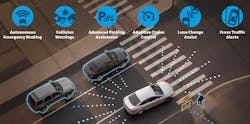This article is part of the TechXchange on Automotive Radar
What you'll learn:
- What is 4D radar?
- What are the key components that make it work?
- Who are the competitors?
In contrast to cameras and LiDAR, 4D imaging radar uses echolocation and the principle of time-of-flight measurement to find things in its environment. It works well in all weather and environment conditions, including fog, heavy rain, and darkness. 4D imaging radar can tell when a car is moving and at what speed in a full white-out snowstorm. It also has the benefit of sensing out to 300 meters—a requirement for higher levels of automation.
4D is called 4D because it’s a high-resolution long-range radar sensor that not only detects the distance, relative speed, and azimuth (an angular measurement in a spherical coordinate system) of objects, but also their height above road level.
Time is considered the fourth dimension (4D). These radars aren’t really mapping time, but rather utilize time to understand the 3D environment with regards to elevation. This can help a car decide whether a stationary object up ahead is a person or a tree branch.
Unlike traditional radar solutions that are based around two to three transmitting antennas and three to four receiving antennas, 4D imaging radar leverages a multiple-input, multiple-output (MIMO) 48-antenna array for high-resolution mapping of its surroundings. The point cloud data output—a dataset that represents objects—combined with a wide azimuth-elevation field of view (FOV) delivers detection and tracking with greater accuracy for situations such as a traffic jam under a bridge.
Vayyar Radar-On-Chip
A number of suppliers are developing 4D imaging radar. Vayyar recently became the latest to unveil a production-ready “radar-on-chip.” Its multifunction automotive-grade, AEC-Q100-qualified device features up to 48 transceivers, an internal digital signal processor (DSP), and a microcontroller unit (MCU) for real-time signal processing. Capable of seeing through objects and able to operate effectively in all weather conditions, Vayyar claims its solution can replace over a dozen other sensors and negates the need for LiDAR and cameras. Thus, it reduces complexity for both in-cabin and ADAS applications with just a single radio-frequency integrated circuit.
The chip covers imaging and radar bands from 3 to 81 GHz with 72 transmitters and 72 receivers. Employing an integrated DSP with internal memory, Vayyar says that its sensor can execute complex imaging algorithms without need for an external CPU.
Within the cabin, the Vayyar chip supports a multitude of systems, including intruder alerts, child presence detection, seat belt reminders, and eCall to alert emergency services in the event of a crash. Outside the car, just two to four sensors support nearly a dozen ADAS and advanced parking-assistance applications, according to the company.
Vayyar wrote in a news release that the average vehicle today sported more than 100 sensors, with analysts predicting that this will double by 2030. The supplier noted that some of them only have a single job. The company’s 60- and 79-GHz radar modules are designed to reduce the number of sensors in vehicles. They’re said to replace over a dozen other sensors and negate the need for LiDAR and cameras while simultaneously tracking multiple targets and objects.
Central to the platform's potential is its ability to reduce complexity. To cut direct and indirect costs, Vayyar offers a full end-to-end solution that includes hardware, software, and development and testing resources, streamlining the integration process. The sensor is also said to be engineered for scalability, facilitating the deployment of emerging features via over-the-air (OTA) software updates.
NXP and Continental 4D Entries
Responding to the needs of the automotive industry, NXP Semiconductors announced on December 7th that it is sampling a suite of new radar sensor chipsets, consisting of the company’s S32R45 radar processor and new 77-GHz transceivers called TEF82xx. Each chip incorporates three transmit and four receive channels. The 7.5- × 7.5-mm exposed die package provides enhanced thermal performance and is ISO26262 ASIL Level B compliant.
Continental AG is using Xilinx FPGAs to deploy production-ready 4D imaging radar, expected to ship in passenger vehicles in 2021. In developing a new 4D radar sensor generation, the company relies on SoCs from Xilinx's Zynq UltraScale+ family. With the ARS540, Continental offers an antenna array with digital beamforming, and 28 physical and 192 virtual antenna channels generating high-resolution radar images.
The system can classify radar echoes according to the type of traffic participant; i.e., it distinguishes between trucks, cars, bicycles, and pedestrians. Continental’s ARS 540 4D imaging radar supports automated driving systems all the way from partial to full automation. It calculates an object’s location and elevation in addition to range, speed, and azimuth angle, even allowing relatively small objects to be detected, to create a precise map of the driving environment up to 300 meters.
Uhnder the Radar
Uhnder, an Austin, Texas digital imaging 4D radar-on-chip developer, has technology that gives vehicles the versatility for a wide range of applications such as automotive ADAS and semi and fully autonomous driving. The company’s digital imaging radar chip is said to offer improved resolution and detection capabilities over traditional analog frequency modulation, leading to increased safety. Traditional radar relies on frequency-modulated continuous waves (FMCW) that modulate the frequency of sinusoid waveforms to transmit and receive a signal.
Uhnder’s radar sensor IC is a software-defined radar incorporating digital-signal-processing techniques, such as MIMO. In MIMO radar, a single transmit (Tx) and eight receive (Rx) antennas form a single-input, multiple-output (SIMO) radar. The distance between the Rx antennas is chosen to achieve the desired FOV.
This imaging technology is based on something called digital code modulation (DCM). DCM technology uses a phase to modulate the transmit signal rather than the frequency during a given time period, called the chip period or chip duration, and then adds digital code to the phase to achieve more precise measurements.
The Uhnder RoC integrates a 77- to 79-GHz transceiver with 12 transmit and 16 receive channels that can be time-multiplexed to two sets of antennas, covering both azimuth and elevation profiles. According to the company, this RoC architecture can process up to 192 virtual receive channels without external RF PCB circuitry. Thanks to the large number of virtual receivers, it achieves high angular resolution. A radar’s angular resolution is directly proportional to the effective area of its antenna array, typically referred to as the antenna aperture.
By obtaining more parameters than traditional radar or LiDAR, such as the elevation of an object, Uhnder says its system can resolve juxtaposed objects that are undetectable by traditional sensors.
Check out more content in the TechXchange on Automotive Radar

